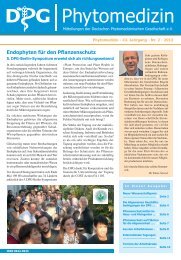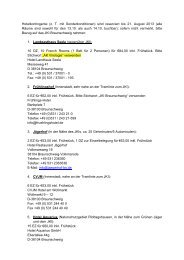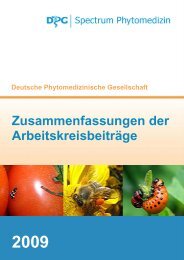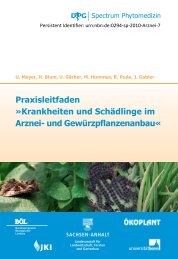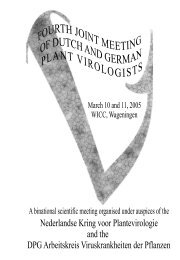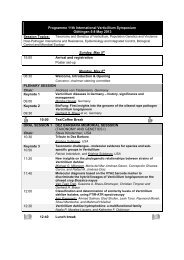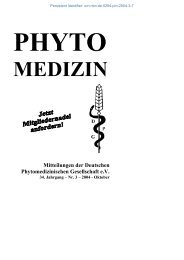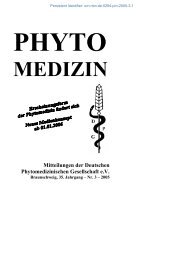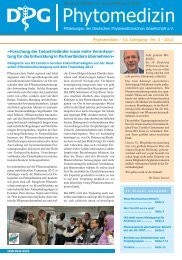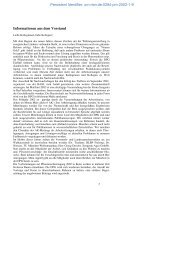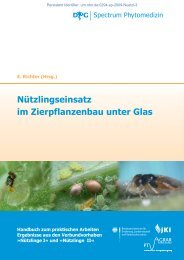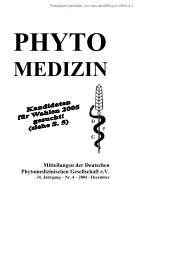Zusammenfassungen der Arbeitskreisbeiträge - Die DPG
Zusammenfassungen der Arbeitskreisbeiträge - Die DPG
Zusammenfassungen der Arbeitskreisbeiträge - Die DPG
Sie wollen auch ein ePaper? Erhöhen Sie die Reichweite Ihrer Titel.
YUMPU macht aus Druck-PDFs automatisch weboptimierte ePaper, die Google liebt.
CONTROLLING MELOIDOGYNE INCOGNITA IN TOMATO BY CO-<br />
INOCULATION OF THE BIOCONTROL AGENTS FUSARIUM OXYSPORUM<br />
STRAIN FO162 AND RHIZOBIUM ETLI STRAIN G12<br />
Martinuz, Alfonso 1 , Schouten, Alexan<strong>der</strong> 2 , Sikora, Richard A. 1<br />
1<br />
INRES-Plant Health, University of Bonn, Nussallee 9, 53115 Bonn, Germany<br />
2<br />
INRES-Molecular Phytomedicine, University of Bonn, Karlrobert-Kreiten-Strasse 13, 53115<br />
Bonn, Germany<br />
Contact: martinuz@catie.ac.cr<br />
Both the endophytic fungus Fusarium oxysporum strain Fo162 and bacterium Rhizobium etli<br />
strain G12 have been shown to systemically reduce the colonization of the root knot<br />
nematode, Meloidogyne incognita. The simultaneous application of both organisms may<br />
herefore be a strategy to further increase the biocontrol efficacy. Through a triple split-root<br />
experiment we determined that the simultaneous but spatially-separated inoculation of both<br />
endophytes did not lead to a significant additive effect with respect to reducing M. incognita<br />
penetration. Furthermore, this co-inoculation showed a significant reduction in root<br />
colonization by Fo162. A split-root experiment showed that the simultaneous but spatiallyseparated<br />
inoculation of both Fo162 and G12 again resulted in a reduction in Fo162<br />
colonization, indicating that the fungus can be systemically repressed by the bacterium.<br />
Antibiosis tests indicated that there was a reduction in radial growth of Fo162, when<br />
challenged with G12, suggesting that the fungus can be also directly affected by the<br />
bacterium, probably by the production of secondary metabolites. The overall results indicated<br />
that the co-inoculation with the endophytic fungus Fo162 and the endophytic bacterium G12<br />
cannot really enhance the biocontrol efficacy against the nematode M. incognita, which is<br />
most likely attributed to direct and indirect interactions between the two biocontrol organisms.<br />
Thus, although Fo162 and G12 have the ability to induce systemic resistance towards M.<br />
incognita, they can be consi<strong>der</strong>ed incompatible biocontrol agents when combined together.<br />
BODENVERSCHLEPPUNG WÄHREND DES KARTOFFELANBAUS UND DAS<br />
DAMIT VERBUNDENE RISIKO DER VERBREITUNG VON<br />
KARTOFFELZYSTEN-NEMATODEN<br />
Molendijk, Leen<strong>der</strong>t 1 , Been, Thomas 2<br />
1<br />
PPO-AGV, Wageningen UR, Edelhertweg 1, NL-8219 PH Lelystad, Nie<strong>der</strong>lande<br />
2<br />
Plant Research International, WUR, Plant Science Group<br />
Contact: leen<strong>der</strong>t.molendijk@wur.nl<br />
Kartoffelzysten-Nematoden (Globo<strong>der</strong>a pallida/rostochiensis) sind noch immer einer <strong>der</strong><br />
bedeutendsten Schädlinge im europäischen Kartoffelanbau. Allerdings wissen wir nur wenig<br />
darüber, ob bzw. inwieweit eine Risiko besteht, dass dieser Schädling durch kulturtechnische<br />
(Bodenbearbeitung) als auch erntetechnischen Praktiken (Rodung, Sortieren) weiter<br />
verschleppt wird. Daher wurde unter Führung von PRI (Plant Research International,<br />
Wageningen UR) und PPO-AGV (Praktijkon<strong>der</strong>zoek Plant en Omgeving, Wageningen UR)<br />
ein entsprechen<strong>der</strong> Feldversuch durchgeführt. Dabei wurde zunächst ein ca. 240m2 großer<br />
Befallsherd mit Plastikzysten simuliert, <strong>der</strong> im Zentrum eine Befallsdichte von 350 Zysten/kg<br />
Boden aufwies (insgesamt beinahe 8 Mio. Zysten). Nachfolgend wurden auf dieser Parzelle<br />
Kartoffeln angebaut. Während des Pflanzens, <strong>der</strong> Bodenbearbeitung, <strong>der</strong> Rodung und dem<br />
Sortieren <strong>der</strong> Kartoffeln wurde jeweils evaluiert, inwieweit dies eine Risiko für die<br />
ungewollte Verbreitung <strong>der</strong> Zysten darstellt. Zusammenfassend stellte sich dabei heraus, dass<br />
sich <strong>der</strong> Verseuchungsherd durch das Pflanzen, Anhäufeln und durch an<strong>der</strong>e Maßnahmen <strong>der</strong><br />
Bodenbearbeitungen um mehr als 15 m in beide Richtungen ausgeweitet hatte.<br />
��



